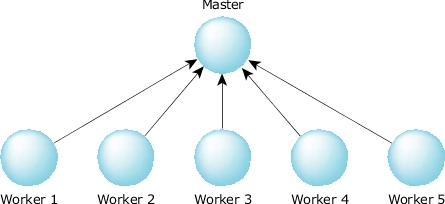Because the master program is delegating work to worker programs, the master program can't afford to become blocked on any one program! In a traditional send-driven approach, you'd expect the master to create a program and then send to it. Unfortunately, the master program wouldn't be replied to until the worker program was done, meaning that the master program couldn't send simultaneously to another worker program, effectively negating the advantages of having multiple worker nodes.
 Figure 1. One master, multiple workers.
Figure 1. One master, multiple workers.The solution to this problem is to have the worker programs start up, and ask the master program if there's any work to do by sending it a message. Once again, we've used the direction of the arrows in the diagram to indicate the direction of the send. Now the worker programs are waiting for the master to reply. When something tells the master program to do some work, it replies to one or more of the workers, which causes them to go off and do the work. This lets the workers go about their business; the master program can still respond to new requests (it's not blocked waiting for a reply from one of the workers).